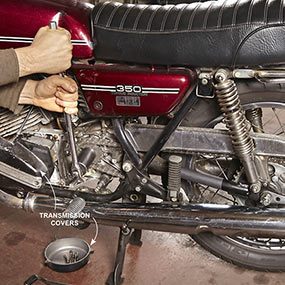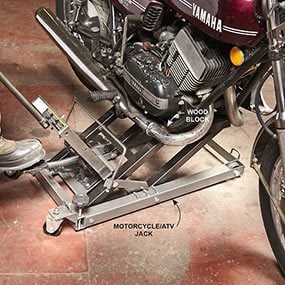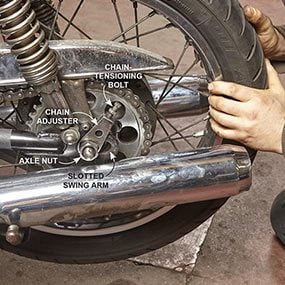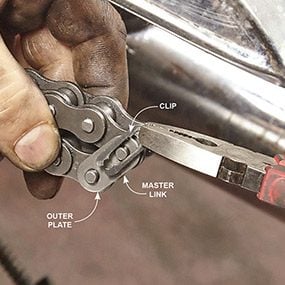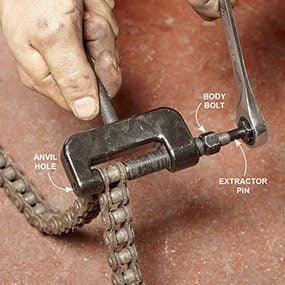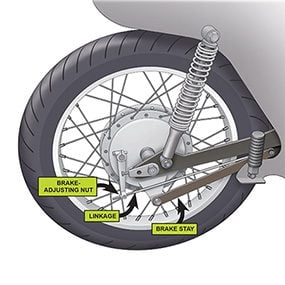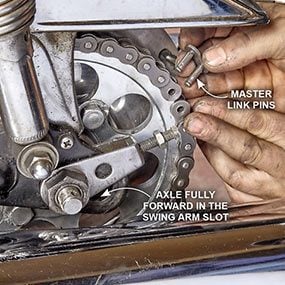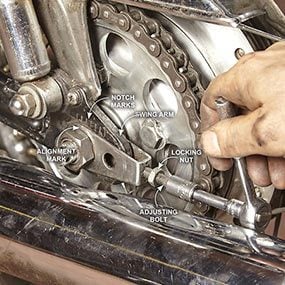How to Change a Motorcycle Chain and Sprockets
Updated on Mar. 28, 2023We asked an expert to walk us through the entire component replacement process with a Yamaha 350.
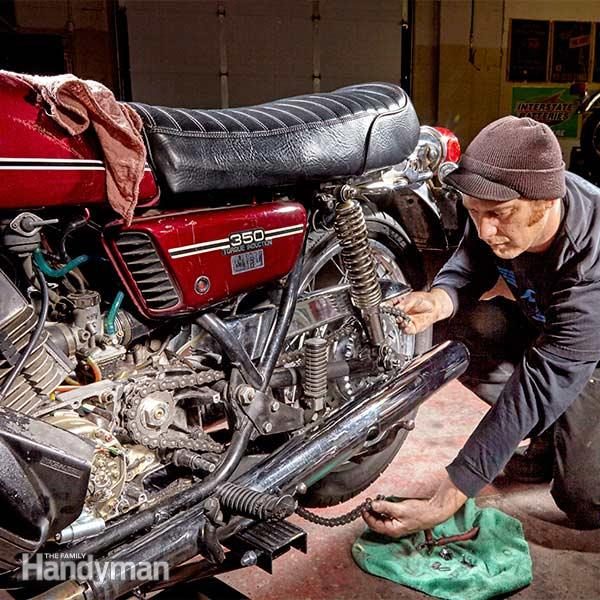
- Time
- Complexity
- Cost
- A full day
- Beginner
- $51–100
Start at the drive sprocket nut
Remove the transmission cover to gain access to the drive sprocket and nut. The nut is often held in place with metal tabs, so bend the tabs down before trying to loosen the nut. Then, with the rear wheel on the ground, loosen the nut with a breaker bar and socket (Photo 1).
Next, raise and support the bike using the bike’s builtin stand, blocks and jack stands, or a motorcycle jack (Photo 2). A motorcycle jack is safest because it provides the best side-to-side stability. (The jack shown, No. 61632, is available at harborfreight.com).
How do you know when to replace components?
Chains stretch as they wear, and all bikes include an adjustment mechanism to take up the slack. Once you reach the maximum adjustment point, it’s time to replace the chain.
To check for sprocket wear, examine the top portion of each tooth and the valley between the sprocket teeth. The top of each tooth should be flat, and the valley should be U-shaped and symmetrical. On a worn sprocket, the top of the tooth wears to a sharp point and the valley becomes elongated on the thrust side. If you notice edge wear at the top of the tooth or elongation, it’s time to replace the sprockets.
Remove and replace the components
Relieve the chain tension by loosening the chain adjusting bolt and the rear axle nut. Then push the rear wheel forward and remove the chain (Photo 3).
If the chain has a master link, remove the clip with a pair of pliers and disassemble the chain (Photo 4). If your chain doesn’t have a master link, you’ll need a chainbreaking tool (such as the Heavy Duty Chain Breaker, No. 66488 at harborfreight.com). Mount the tool and break the chain (Photo 5). Then discard the old chain.
Next, disconnect the rear drum brake linkage and the stay (Figure A). If your bike has disc brakes, remove the caliper.
Slide the rear axle out and remove the rear wheel and brake assembly. Place the wheel on a workbench and replace the rear sprocket (Photo 6). Then replace the drive sprocket on the transmission.
Reassemble and adjust the chain
Install the rear wheel, axle and brake assembly on the bike. Push the rear wheel all the way forward in the swing arm. Snug the axle nut slightly to hold it in that position. Then roll the new chain around the drive sprocket and onto the rear sprocket with the open link located near the top of the rear sprocket. Install the master link (Photo 7).
Next, tighten the chain-adjusting bolts to obtain 1-in. up/down play on the bottom portion of the chain. Err on the side of too loose rather than too tight (a tight chain causes rapid wear). Then true up the rear wheel (Photo 8). Tighten the axle nut to spec using a torque wrench and insert the cotter key (where applicable). Torque the drive sprocket nut to spec (rear wheel on the ground) and bend the tabs against the flats of the nut. Reinstall the transmission covers.
Beware of low-cost parts
As in other industries, the motorcycle parts market is flooded with substandard imitations and counterfeit name brand parts that don’t come close to the original manufacturers’ specifications. That’s why it’s best to buy parts from an authorized dealer or a trusted repair shop. If you shop online, check out the seller’s reviews first. An exceptionally low price on a name brand part is a red flag that the part may be a fake.
Lube and go
Lubricate the chain with spray chain lube and rotate the wheel several times to work it into the links. Then drive the bike slowly to fling off the excess before you hit the gas.
